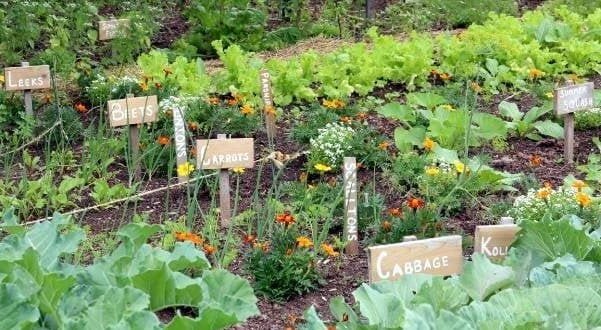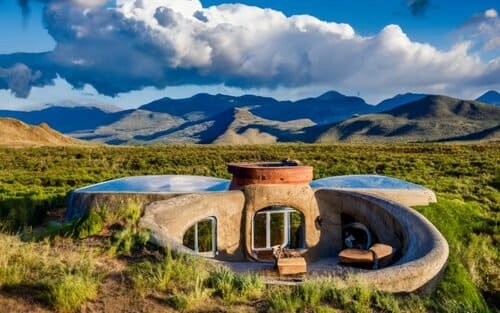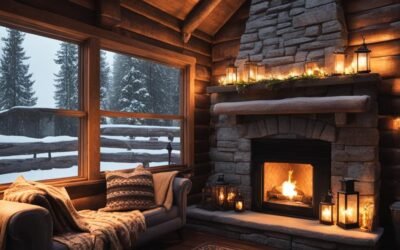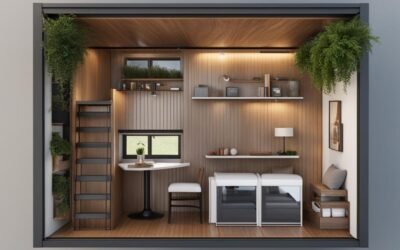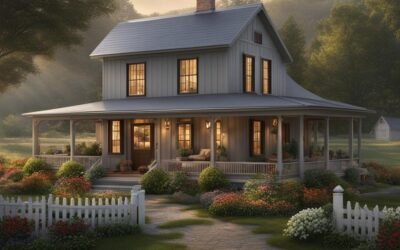In my personal journey of upgrading my tiny house exterior, I have explored various creative designs and savvy solutions. The inspiration for my project came from a Tumbleweed Tiny Houses plan, which resulted in a 160 sq. ft. home that I built over a year without any prior construction experience. The interior design became my favorite part, as I had to come up with clever space savers to maximize the limited square footage. Living in my tiny house for almost four years, I have made changes and upgrades to evolve the home to suit my needs.
When it came to designing my tiny house exterior, I sought out creative ideas to make the most of the limited space. I experimented with different paint colors to add personality and curb appeal to my home. Additionally, I explored various exterior materials such as cedar shingles, Hardie board planks, vinyl siding, and corrugated metal. These materials offered a balance between aesthetics and long-term maintenance for my tiny house.
Key Takeaways:
- During my tiny house exterior design journey, I focused on maximizing the limited space and creating a visually appealing home.
- Experimenting with different paint colors and exterior materials allowed me to personalize my tiny house exterior.
- Choosing durable and low-maintenance materials, such as cedar shingles and Hardie board planks, ensured the longevity of my tiny house exterior.
- I learned the importance of attention to detail and practical design elements when upgrading the exterior finishes of my tiny house.
- Maximizing the curb appeal of my tiny house not only made it visually appealing, but also created a welcoming space.
Creative Tiny House Exterior Ideas
When it came to designing my tiny house exterior, I was determined to think outside the box and find innovative ideas to make the most of the limited space. Here are some creative tiny house exterior ideas that I explored:
- Experimenting with Paint Colors: I quickly realized that the right paint color can completely transform the look of a tiny house. I experimented with different shades to add personality and curb appeal to my home. From vibrant hues that made a bold statement to soft pastels that created a charming and inviting vibe, the options were endless. As a result, my tiny house became a standout in the neighborhood.
- Exploring Exterior Materials: The choice of materials for the exterior of a tiny house is crucial, as it affects both aesthetics and long-term maintenance. I delved into various options such as:
| Material | Description |
|---|---|
| Cedar Shingles | A natural and timeless choice that offered a rustic and cozy look to my tiny house. |
| Hardie Board Planks | A durable and low-maintenance option that mimicked the appearance of wood while providing enhanced protection against the elements. |
| Vinyl Siding | An affordable and easy-to-clean material that came in a variety of colors and styles, allowing me to achieve the desired aesthetic. |
| Corrugated Metal | A modern and industrial choice that added a unique and eye-catching element to my tiny house exterior. |
Each material had its own advantages and considerations, and I carefully weighed the pros and cons before making my selection. The result was an exterior that not only looked stunning but also stood the test of time.
Upgrading Tiny House Exterior Finishes
As I continued my journey of transforming my tiny house, one crucial aspect that demanded attention was the exterior finishes. I wanted to elevate the appearance of my home and give it a refreshing update. Exploring various options for siding materials and carefully selecting the right finishes became the key focus of this phase.
Exploring Siding Materials
I delved into researching different siding materials that would not only enhance the overall look of my tiny house but also provide durability and low maintenance. After thorough consideration, I narrowed down my choices to two: cedar shingles and Hardie board planks.
Cedar Shingles – With their natural beauty and timeless appeal, cedar shingles stood out as a top contender. These wooden shingles bring a rustic charm to the exterior, creating a warm and inviting ambiance. Their durability, resistance to rot and insects, and ability to insulate the home were additional factors that swayed my decision.
Hardie Board Planks – Another option that caught my attention was Hardie board planks, a fiber cement siding material. Known for its exceptional durability and resistance to extreme weather conditions, Hardie board offered a modern and sleek aesthetic. Additionally, its fire resistance and low maintenance made it an attractive choice for a tiny house.
Personalizing the Exterior
With the siding materials chosen, I could now focus on infusing my personal touch and creating a fresh, updated appearance for my home. I decided to combine the natural beauty of cedar shingles with the modern appeal of Hardie board planks.
Incorporating cedar shingles on the lower half of the house provided a warm and inviting foundation. To add a contemporary touch, I opted for Hardie board planks on the upper half and as accents around the windows and doors. This combination created a visually pleasing contrast, giving my tiny house a unique and personalized look.
The renovation process was an opportunity to express my creativity and enhance the overall aesthetics of my tiny house. Each choice I made was carefully considered to achieve a harmonious blend of materials and finishes, resulting in a visually appealing exterior.
Final Touches and Reflection
Alongside the siding materials, I added custom details such as trim color options and decorative accents to further elevate the exterior design. Paying attention to even the smallest elements ensured a cohesive and well-thought-out final look.
This upgrade not only enhanced the curb appeal of my tiny house but also left me with a sense of pride and accomplishment. The exterior now reflects my unique personality and provides a welcoming facade to all who visit.
| Siding Material | Benefits |
|---|---|
| Cedar Shingles | Natural beauty, durability, resistance to rot and insects, insulation |
| Hardie Board Planks | Durability, resistance to extreme weather, fire resistance, low maintenance |
Maximizing Tiny House Curb Appeal
 When it comes to my tiny house exterior design, one crucial aspect I focused on was maximizing the curb appeal of my home. I understood the importance of creating a visually appealing and welcoming exterior that would make a statement in the neighborhood. To achieve this, I paid careful attention to the selection of materials, colors, and finishes.
When it comes to my tiny house exterior design, one crucial aspect I focused on was maximizing the curb appeal of my home. I understood the importance of creating a visually appealing and welcoming exterior that would make a statement in the neighborhood. To achieve this, I paid careful attention to the selection of materials, colors, and finishes.
By choosing the right materials for my tiny house exterior, I was able to enhance its overall aesthetics. From siding options to roofing materials, every element played a role in creating a cohesive and attractive exterior design. I wanted my tiny house to stand out while still harmonizing with its surroundings.
Selection of Materials
- I opted for durable and visually appealing siding materials like cedar shingles and Hardie board planks. These options not only added a touch of rustic charm but also ensured long-lasting quality for my tiny house.
- The roofing material I chose was also a crucial factor in enhancing the curb appeal. I considered different options such as asphalt shingles, metal, or even a green roof, weighing their aesthetics and maintenance requirements.
- Additionally, I paid attention to details such as window frames, doors, and trim. These smaller elements contributed to the overall look and feel of the tiny house exterior.
Colors and Finishes
One of the key strategies I employed to maximize curb appeal was the careful selection of colors and finishes. They played a significant role in creating a cohesive and visually striking exterior design. While choosing the right colors, I considered the following:
- The overall look I wanted to achieve: Whether it was a modern, vibrant, or traditional aesthetic, I ensured that the colors I chose aligned with the style and theme of my tiny house.
- The surroundings: I took inspiration from the natural landscape and existing architectural styles in the neighborhood, selecting colors that complemented the environment.
To give my tiny house exterior a polished and well-maintained appearance, I paid attention to finishes such as trim, paint quality, and surface treatments. These details added depth and character to the overall design of my small home.
By maximizing the curb appeal of my tiny house, I not only created a visually appealing exterior, but I also enhanced the overall value of my home. The careful selection of materials, colors, and finishes transformed my tiny house into a charming and welcoming space that truly stands out.
Choosing Tiny House Exterior Materials
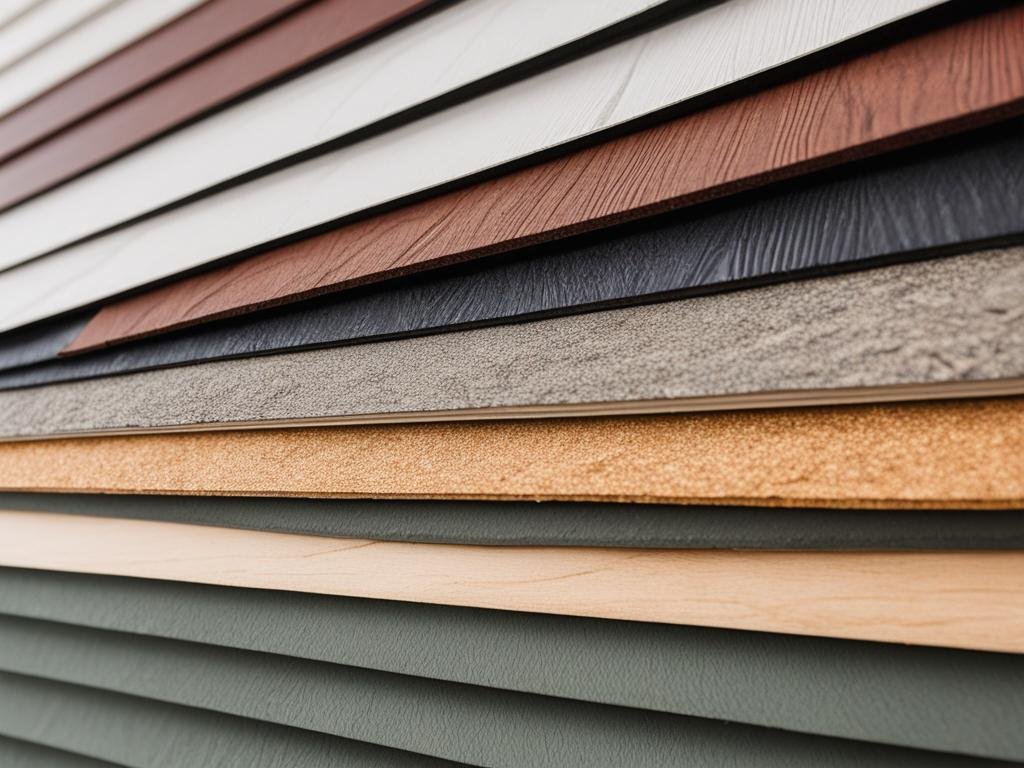 When it came to designing my tiny house exterior, one of the most important decisions I had to make was choosing the right materials. I considered several factors, including durability, maintenance requirements, and visual appeal. After careful research and consideration, I narrowed down my options to four main materials: cedar shingles, Hardie board planks, vinyl siding, and corrugated metal.
When it came to designing my tiny house exterior, one of the most important decisions I had to make was choosing the right materials. I considered several factors, including durability, maintenance requirements, and visual appeal. After careful research and consideration, I narrowed down my options to four main materials: cedar shingles, Hardie board planks, vinyl siding, and corrugated metal.
Each material had its own advantages and considerations that influenced my decision-making process. Let’s take a closer look at each of them:
Cedar Shingles
Cedar shingles are a classic choice for tiny house exteriors. They have a natural beauty and warmth that adds character to any home. Cedar is also known for its durability and resistance to rot, pests, and weathering. However, it does require regular maintenance, including staining or sealing to maintain its appearance and protect it from the elements.
Hardie Board Planks
Hardie board planks, also known as fiber cement siding, are another popular option for tiny house exteriors. Made from a combination of cement, sand, and cellulose fibers, this material is incredibly durable and resistant to rot, fire, and pests. It also comes in a wide range of colors and styles, allowing for great design versatility. The only downside is that it can be heavier than other options, which may require additional structural support.
Vinyl Siding
Vinyl siding is a low-maintenance and budget-friendly choice for tiny house exteriors. It is lightweight, easy to install, and comes in a variety of colors and textures. Vinyl is also resistant to rot, pests, and fading, making it a durable option. However, some people may not prefer its plastic appearance or the potential environmental impact associated with its production and disposal.
Corrugated Metal
Corrugated metal, often used in industrial-style homes, can add a modern and sleek look to a tiny house exterior. It is highly durable, weather-resistant, and low-maintenance. Corrugated metal is available in different finishes, such as zinc, galvanized steel, or painted steel, allowing for various design possibilities. However, it may not be suitable for everyone’s aesthetic preferences, as it can create a more industrial or rustic look.
In the end, I chose to use Hardie board planks for my tiny house exterior. The combination of durability, design versatility, and low maintenance made it the perfect choice for me. However, the selection of materials ultimately depends on personal preferences, budget, and the desired aesthetic for your tiny house.
Remember to carefully consider the pros and cons of each material, as well as their long-term maintenance requirements, before making a decision. By choosing the right exterior materials, you can not only enhance the overall look of your tiny house but also ensure its longevity and protection against the elements.
Conclusion
In conclusion, my journey of designing the exterior of my tiny house has been a transformative experience. Throughout this process, I have researched and implemented clever space-saving ideas, upgraded the finishes, and focused on enhancing the curb appeal. This journey has taught me the importance of personalizing and evolving my tiny home to suit my needs, while also showcasing the potential of small house exteriors.
By carefully selecting exterior materials and paying attention to design details, I have created a unique and functional living space that defies its limited square footage. From exploring different paint colors to considering durable siding options like cedar shingles and Hardie board planks, I have found the perfect balance between aesthetics and practicality.
Embarking on this tiny home exterior design journey has shown me that even with a small house exterior, it is possible to create a stylish and inviting space. By making thoughtful choices and prioritizing my preferences, I have successfully transformed my tiny house into a home that reflects my personality and meets my needs. The exterior of a tiny home should not be underestimated and can truly make a statement in any neighborhood.
FAQ
What inspired your tiny house exterior design?
The inspiration for my tiny house exterior design came from a Tumbleweed Tiny Houses plan.
How did you make the most of the limited space in your tiny house exterior design?
I experimented with different paint colors and explored various exterior materials to maximize the limited space.
What materials did you consider for your tiny house exterior?
I considered materials such as cedar shingles, Hardie board planks, vinyl siding, and corrugated metal.
How did you upgrade your tiny house exterior finishes?
I embarked on a journey of renovating my tiny house exterior and upgrading the finishes, including the siding materials.
How did you maximize the curb appeal of your tiny house?
I focused on enhancing the overall aesthetics of the exterior through careful selection of materials, colors, and finishes.
What factors did you consider when choosing the exterior materials for your tiny house?
I considered factors such as durability, maintenance requirements, and visual appeal when selecting materials like cedar shingles, Hardie board planks, vinyl siding, and corrugated metal.



